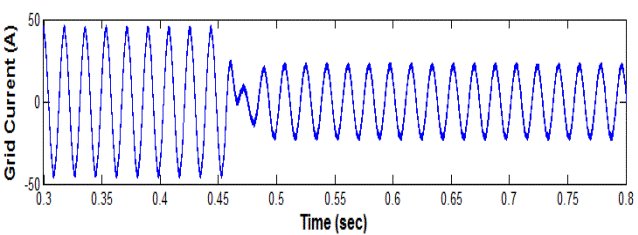This paper
describes a position sensorless operation of permanent magnet brushless direct
current (BLDC) motor. The position sensorless BLDC drive proposed, in this
paper, is based on detection of back electromotive force (back EMF) zero
crossing from the terminal voltages. The proposed method relies on a difference
of line voltages measured at the terminals of the motor. It is shown, in the
paper, that this difference of line voltages provides an amplified version of
an appropriate back EMF at its zero crossings. The commutation signals are obtained
without the motor neutral voltage. The effectiveness of the proposed method is
demonstrated through simulation and experimental results.
KEYWORDS:
1. Back electromotive force (EMF) detection
2. Brushless dc
(BLDC) motor
3. Sensorless control
4. Zero crossing
SOFTWARE: MATLAB/SIMULINK
BLOCK DIAGRAM:
Fig. 1. Block diagram of the experimental
setup.
EXPECTED SIMULATION RESULTS:
Fig.
2. Phase current and speed waveform on no-load (experimental).
Fig.
3. Phase current and speed waveform on load (experimental).
Fig.
4. Phase current and speed waveform during loading transient (experimental).
Fig.
5. Phase current, virtual Hall, and real Hall sensor signal for 50% duty
ratio
PWM switching.
CONCLUSION:
A simple technique to detect back EMF
zero crossings for a BLDC motor using the line voltages is proposed. It is
shown that the method provides an amplified version of the back EMF. Only three
motor terminal voltages need to be measured thus eliminating the need for motor
neutral voltage. Running the machine in sensorless mode is then proposed, in
this paper, making use of the novel zero-crossing detection algorithm. While
starting relies on triggering devices at the zero crossings detected using the
proposed algorithm, continuous running is achieved by realizing the correct
commutation instants 30◦ delay
from the zero crossings. The motor is found to start smoothly and run sensorless
even with load and load transients. Simulation and experimental results are
shown which validate the suitability of the proposed method.
REFERENCES:
[1] K. Iizuka,H.Uzuhashi, M. Kano, T.
Endo, and K.Mohri, “Microcomputer control for sensorless brushless motor,” IEEE
Trans. Ind. Appl., vol. IA- 21, no. 4, pp. 595–601, May/Jun. 1985.
[2] J. Shao, D. Nolan,M. Teissier, and
D. Swanson, “A novel micro controller based sensorless brushless DC (BLDC) motor
drive for automotive fuel pumps,” IEEE Trans. Ind. Appl., vol. 39, no.
6, pp. 1734–1740, Nov./Dec. 2003.
[3] T.-H. Kim and M. Ehsani, “Sensorless
control of BLDC motors from near-zero to high speeds,” IEEE Trans. Power
Electron., vol. 19, no. 6, pp. 1635–1645, Nov. 2004.
[4] S. Ogasawara and H. Akagi, “An
approach to position sensorless drive for brushless DC motors,” IEEE Trans.
Ind. Appl., vol. 27, no. 5, pp. 928–933, Sep./Oct. 1991.
[5] R. C. Becerra, T. M. Jahns, and M.
Ehsani, “Four-quadrant sensorless brushless ECM drive,” in Proc. IEEE APEC,
Mar. 1991, pp. 202–209.




























